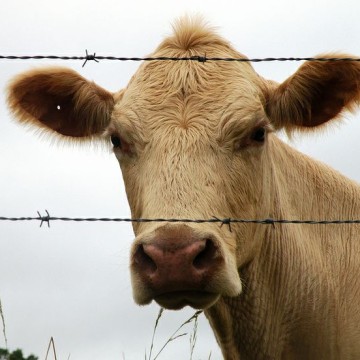Last year, Modern Meadow CEO Andras Forgas delivered a fascinating TED talk on lab-produced “real” meat and leather—animal products, that is, without the usual killing and abuse of animals. The company predicts being able to mass-produce meat by 2017.
To create leather or meat, cells are gathered from an animal, then multiplied and fused to create cultured meat that’s identical to beef, chicken, bovine skin, or what have you (of course, that’s the highly simplified version of the process. You can the full story here).
As an animal-rightist, I’m most interested in the animals’ involvement in the process—how those cells are gathered in the first place. Donor animals are usually those already slated for slaughter for food and/or leather purposes. Cells are collected through a punch biopsy, a procedure commonly performed on humans to diagnose skin disorders. A small plug of skin is extracted, followed by simple stitches. With anesthesia, discomfort is minimal.
With cultured animal products, Modern Meadow aims to:
-End the killing of animals for meat/leather while still meeting the world’s demand for meat.
-Eliminate the toxic process of leather tanning.
-Create more durable leather products.
-Eliminate waste from the leather industry by customizing the shape of leather. Because cows don’t come in the shape of a sofa, roughly 20% of leather is unusable and wasted. (Though sometimes leather scraps are “recycled.”)
-Reduce our carbon footprint—as we know, conventional farming plays an astounding role in global warming.
As a vegan in a developed country, living without animal products is completely doable for me (and many others in my living situation). I can imagine a world in which no animal (or human!) exploitation seems necessary to anyone, where neither conventional nor lab grown leather and meat is particularly desirable. But we are not there yet. If vegans’ ultimate goal is to eliminate animal suffering, is it wrong to acknowledge another way of achieving that goal than universal veganism? (Assuming that donor cells are extracted from animals that are not farmed for food).
It may be also said that growing animal cells in a petri dish is morally objectionable because it is taking advantage of living things. But the intuitive response can be countered by a more utilitarian perspective. For instance, Forgas’s previous startup, Organovo, uses 3-D bioprinting technology to produce human tissues for transplants and medical research. Here it is easy to imagine that the benefits of technology outweigh any moral concerns over the sanctity of human cells. Just as human cells are not living, breathing humans, animal cells are not equal to sentient, feeling, social animals.
There are drawbacks, of course, to this proposed solution. Cultured meat and leather will likely be prohibitively expensive for the average consumer at first. And there is the intangible consumer taste to consider–for many, lab-made meat will be a little too sci-fi, if not downright repugnant. Nonetheless, Modern Meadow has given us something to think about, if not a glimpse into the future.
Curiosity is my primary feeling towards this project. I don’t miss meat and wouldn’t have any interest in trying cultured meat, but I’m staying tuned to see how lab grown animal products shift our attitude towards the commodification of sentient life.
What are your thoughts on this developing technology?
Related: Why In Vitro Meat Isn’t the Solution to World’s Problems
Also in News: Veganism and the Melting of the Antarctic Ice Sheet
Why New Vegan Companies Succeed in a Non Vegan World
Photo: The Unquiet Librarian via Flickr





